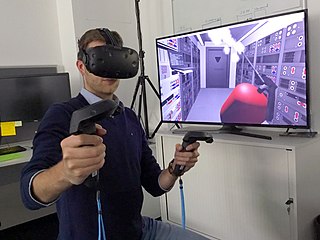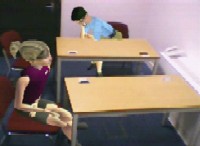Multimedia is content that uses a combination of different content forms such as text, audio, images, animations, video and interactive content. Multimedia contrasts with media that use only rudimentary computer displays such as text-only or traditional forms of printed or hand-produced material.

Virtual reality (VR) is a simulated experience that can be similar to or completely different from the real world. Applications of virtual reality can include entertainment and educational purposes. Other, distinct types of VR style technology include augmented reality and mixed reality.
A simulation is an approximate imitation of the operation of a process or system; that represents its operation over time.

Video on demand (VOD) is a media distribution system that allows users to access videos without a traditional video playback device and the constraints of a typical static broadcasting schedule. In the 20th century, broadcasting in the form of over-the-air programming was the most common form of media distribution. As Internet and IPTV technologies continued to develop in the 1990s, consumers began to gravitate towards non-traditional modes of content consumption, which culminated in the arrival of VOD on televisions and personal computers.
Autodesk, Inc. is an American multinational software corporation that makes software services for the architecture, engineering, construction, manufacturing, media, education, and entertainment industries. Autodesk is headquartered in San Rafael, California, and features a gallery of its customers' work in its San Francisco building. The company has offices worldwide. Its U.S. locations are California, Oregon, Colorado, Texas, Michigan, New Hampshire and Massachusetts. Its Canada offices are located in Ontario, Quebec, and Alberta.
Technological convergence is a theory which refers to the tendency for technologies that were originally unrelated to become more closely integrated and even unified as they develop and advance. The concept is roughly analogous to convergent evolution in biological systems, such that the ancestors of whales became progressively more like fish in outward form and function, despite not being fish and not coming from a fish lineage. In technological convergence, a cardinal example to convey the concept is that telephones, television, and computers began as separate and mostly unrelated technologies but have converged in many ways into interrelated parts of a telecommunication and media industry underpinned by common elements of digital electronics and software.
A train simulator is a computer based simulation of rail transport operations. They are generally large complicated software packages modeling a 3D virtual reality world implemented both as commercial trainers, and consumer computer game software with 'play modes' which lets the user interact by stepping inside the virtual world. Because of the near view modeling, often at speed, train simulator software is generally far more complicated and difficult software to write and implement than flight simulator programs.

Mixed reality (MR) is the merging of real and virtual worlds to produce new environments and visualizations, where physical and digital objects co-exist and interact in real time. Mixed reality does not exclusively take place in either the physical or virtual world, but is a hybrid of reality and virtual reality, encompassing both augmented reality and augmented virtuality via immersive technology.

Streaming television is the digital distribution of television content, such as TV shows, as streaming video delivered over the Internet. Streaming TV stands in contrast to dedicated terrestrial television delivered by over-the-air aerial systems, cable television, and/or satellite television systems. The use of streaming online video and web television by consumers has seen a dramatic increase ever since the launch of online video platforms such as YouTube and Netflix.
Digital distribution is the delivery or distribution of digital media content such as audio, video, e-books, video games, and other software. The term is generally used to describe distribution over an online delivery medium, such as the Internet, thus bypassing physical distribution methods, such as paper, optical discs, and VHS videocassettes. The term online distribution is typically applied to freestanding products; downloadable add-ons for other products are more commonly known as downloadable content. With the advancement of network bandwidth capabilities, online distribution became prominent in the 21st century, with prominent platforms such as Amazon Video, and Netflix's streaming service starting in 2007.
SpeedTree is a group of vegetation programming and modeling software products developed and sold by Interactive Data Visualization, Inc. (IDV) that generates virtual foliage for animations, architecture and in real time for video games and demanding real time simulations.
Building information modeling (BIM) is a process supported by various tools, technologies and contracts involving the generation and management of digital representations of physical and functional characteristics of places. Building information models (BIMs) are computer files which can be extracted, exchanged or networked to support decision-making regarding a built asset. BIM software is used by individuals, businesses and government agencies who plan, design, construct, operate and maintain buildings and diverse physical infrastructures, such as water, refuse, electricity, gas, communication utilities, roads, railways, bridges, ports and tunnels.

Content marketing is a form of marketing focused on creating, publishing, and distributing content for a targeted audience online. It is often used by businesses in order to:

Virtway is a serious game developer located in Oviedo, Spain. It was founded in 1999 as a general IT consulting firm, but in 2006 it spun off from its parent company to focus on 3D development and serious gaming as an independent branch of the Indigo Group holding.
Design for All in the context of information and communications technology (ICT) is the conscious and systematic effort to proactively apply principles, methods and tools to promote universal design in computer-related technologies, including Internet-based technologies, thus avoiding the need for a posteriori adaptations, or specialised design.
SnagFilms was a website that offered advertising-supported documentary and independent films. Films were streamed on the website, which contained a library of over 5,000 films. Filmmakers could submit documentaries for consideration as well. The site includeed documentary films produced by National Geographic and titles such as Super Size Me, The Good Son: The Life of Ray Boom Boom Mancini, Kicking It and Nanking.
TurboSquid is a digital media company that sells stock 3D models used in 3D graphics to a variety of industries, including computer games, architecture, and interactive training. The company, headquartered in New Orleans, Louisiana in the United States, is most known for brokering the sale of 3D models in return for a percentage of the sales. As of 2019, TurboSquid has over 800,000 3D models in its library. Turbosquid also has over 130,000 other products available, such as texture maps.
The virtual world framework (VWF) is a means to connect robust 3D, immersive, entities with other entities, virtual worlds, content and users via web browsers. It provides the ability for client-server programs to be delivered in a lightweight manner via web browsers, and provides synchronization for multiple users to interact with common objects and environments. For example, using VWF, a developer can take video lesson plans, component objects and avatars and successfully insert them into an existing virtual or created landscape, interacting with the native objects and users via a VWF interface.
MAK Technologies, formerly doing business as VT MAK, Inc. is a software company based in Cambridge, Massachusetts that provides commercial off-the-shelf (COTS) modeling and simulation software. The company develops and sells software for distributed simulations that system integrators, governments, and research institutions use to build and populate 3D simulated environments. Users include medical, aerospace, defense, and transportation industries. In addition to offering COTS software, MAK provides the following services: simulation content creation, software customization, interoperability, research and development, and training.

Frontier FiOS, also known as FiOS from Frontier or simply FiOS, is a bundled Internet access, telephone, and television service that operates over a fiber-optic communications network in 7 states, including California, Texas, Florida, Indiana, South Carolina, Oregon, and Washington. Service is offered in some areas of the United States by Frontier Communications in areas built out and formerly served by Verizon, using the same infrastructure as its Fios service and continuing to license the FiOS name from Verizon. Other service providers often use fiber optics in the network backbone and existing copper or coax infrastructure for residential users. Frontier's service began in 2009 with the acquisition of portions of Verizon's network, and networked areas expanded through 2015 through similar acquisitions, although some areas do not have service or cannot receive TV and phone service because of franchise agreements.






